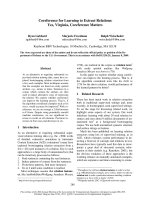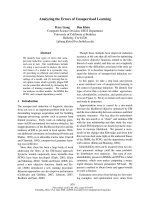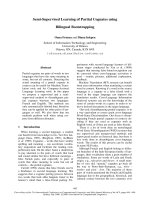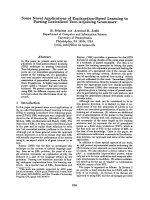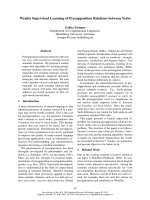Báo cáo khoa học: "Weakly Supervised Learning of Presupposition Relations between Verbs" pptx
Bạn đang xem bản rút gọn của tài liệu. Xem và tải ngay bản đầy đủ của tài liệu tại đây (123.94 KB, 6 trang )
Proceedings of the ACL 2010 Student Research Workshop, pages 97–102,
Uppsala, Sweden, 13 July 2010.
c
2010 Association for Computational Linguistics
Weakly Supervised Learning of Presupposition Relations between Verbs
Galina Tremper
Department of Computational Linguistics
Heidelberg University, Germany
Abstract
Presupposition relations between verbs are
not very well covered in existing lexical
semantic resources. We propose a weakly
supervised algorithm for learning presup-
position relations between verbs that dis-
tinguishes five semantic relations: presup-
position, entailment, temporal inclusion,
antonymy and other/no relation. We start
with a number of seed verb pairs selected
manually for each semantic relation and
classify unseen verb pairs. Our algorithm
achieves an overall accuracy of 36% for
type-based classification.
1 Introduction
A main characteristics of natural language is that
significant portions of content conveyed in a mes-
sage may not be overtly realized. This is the case
for presuppositions: e.g, the utterance Columbus
didn’t manage to reach India. presupposes that
Columbus had tried to reach India. This presup-
position does not need to be stated, but is im-
plicitly understood. Determining the presupposi-
tions of events reported in texts can be exploited
to improve the quality of many natural language
processing applications, such as information ex-
traction, text understanding, text summarization,
question-answering or machine translation.
The phenomenon of presupposition has been
throughly investigated by philosophers and lin-
guists (i.a. Stalnaker, 1974; van der Sandt, 1992).
There are only few attempts for practical imple-
mentations of presupposition in computational lin-
guistics (e.g. Bos, 2003). Especially, presupposi-
tion is understudied in the field of corpus-based
learning of semantic relations. Machine learning
methods have been previously applied to deter-
mine semantic relations such as is-a and part-of,
also succession, reaction and production (Pantel
and Pennacchiotti, 2006). Chklovski and Pantel
(2004) explored classification of fine-grained verb
semantic relations, such as similarity, strength,
antonymy, enablement and happens-before. For
the task of entailment recognition, learning of en-
tailment relations was attempted (Pekar, 2008).
None of the previous work investigated subclassi-
fying semantic relations including presupposition
and entailment, two relations that are closely re-
lated, but behave differently in context.
In particular, the inferential behaviour of pre-
suppositions and entailments crucially differs in
special semantic contexts. E.g., while presup-
positions are preserved under negation (as in
Columbus managed/didn’t manage to reach In-
dia the presupposition tried to), entailments do
not survive under negation (John F. Kennedy
has been/has not been killed). Here the entail-
ment died only survives in the positive sentence.
Such differences are crucial for both analysis and
generation-oriented NLP tasks.
This paper presents a weakly supervised al-
gorithm for learning presupposition relations be-
tween verbs cast as a discriminative classification
problem. The structure of the paper is as follows:
Section 2 reviews state of the art. Section 3 intro-
duces our task and the learning algorithm. Section
4 reports on experiment organization; the results
are presented in Section 5. Finally, we summarise
and present objectives for future work.
2 Related Work
One of the existing semantic resources related to
our paper is WordNet (Fellbaum, 1998). It com-
prises lexical semantic information about English
nouns, verbs, adjectives and adverbs. Among the
semantic relations defined specifically for verbs
are entailment, hyponymy, troponymy, antonymy
and cause. However, not all of them are well cov-
ered, for example, there are only few entries for
presupposition and entailment in WordNet.
97
One attempt to acquire fine-grained semantic
relations from corpora is VerbOcean (Chklovski
and Pantel, 2004). Chklovski and Pantel used a
semi-automatic approach for extracting semantic
relations between verbs using a list of patterns.
The selection of the semantic relations was in-
spired by WordNet. VerbOcean showed good ac-
curacy values for the antonymy (50%), similar-
ity (63%) and strength (75%) relations. How-
ever, VerbOcean doesn’t distinguish between en-
tailment and presupposition; they are conflated in
the classes enablement and happens-before.
A distributional method for extracting highly
associated verbs was proposed by Lin and Pantel
(2001). This method extracts semantically related
words with good precision, but it does not deter-
mine the type and symmetry of the relation. How-
ever, the method is able to recognize the existence
of semantic relations holding between verbs and
hence can be used as a basis for finding and further
discriminating more detailed semantic relations.
3 A Weakly Supervised Approach to
Learning Presupposition Relations
We describe a weakly supervised approach for
learning semantic relations between verbs includ-
ing implicit relations such as presupposition. Our
aim is to perform a type-based classification of
verb pairs. I.e., we determine the class of a verb-
pair relation by observing co-occurrences of these
verbs in contexts that are indicative for their in-
trinsic meaning relation. This task differs from a
token-based classification, which aims at classify-
ing each verb pair instance as it occurs in context.
Classified relations. We distinguish between
the five classes of semantic relations presented in
Table 1. We chose entailment, temporal inclu-
sion and antonymy, because these relations may
be confounded with the presupposition relation.
A special class other/no comprises semantic rela-
tions not discussed in this paper (e.g. synonymy)
and verb pairs that are not related by a semantic re-
lation. The relations can be subdivided into sym-
metric and asymmetric relations, and relations that
involve temporal sequence, or those that do not in-
volve a temporal order, as displayed in Table 1.
A Weakly Supervised Learning Approach.
Our algorithm starts with a small number of seed
verb pairs selected manually for each relation and
iteratively classifies a large set of unseen and un-
Semantic Example Symmetry Temporal
Relation Sequence
Presuppo- find - seek, asymmetric yes
sition answer - ask
Entailment look - see, asymmetric yes
buy - own
Temporal walk - step, symmetric no
Inclusion talk - whisper
Antonymy win - lose, symmetric no
love - hate
Other/no have - own, undefined undefined
sing - jump
Table 1: Selected Semantic Relations
labeled verb pairs. Each iteration has two phases:
1. Training the Classifiers We independently
train binary classifiers for each semantic re-
lation using both shallow and deep features.
2. Ensemble Learning and Ranking Each of
the five classifiers is applied to each sentence
from an unlabeled corpus. The predictions
of the classifiers are combined using ensem-
ble learning techniques to determine the most
confident classification. The obtained list of
the classified instances is ranked using pat-
tern scores, in order to select the most reliable
candidates for extension of the training set.
Features. Both shallow lexical-syntactic and
deep syntactic features are used for the classifica-
tion of semantic relations. They include:
1. the distance between two analyzed verbs and
the order of their appearance
2. verb form (tense, aspect, modality, voice),
presence of negation and polarity verbs
1
3. coordinating/subordinating conjunctions
4. adverbial adjuncts
5. PoS-tag-contexts (two words preceding and
two words following each verb)
6. the length of the path of grammatical func-
tions relating the two verbs
7. co-reference relation holding between the
subjects and objects of the verbs (both verbs
have the same subject/object, subject of one
verb corresponds to the object of the second
or there is no relation between them).
In order to extract these features the training
corpus is parsed using a deep parser.
1
Polarity verbs are taken from the polarity lexicon of
Nairn et al. (2006). It encodes whether the complement of
proposition embedding verbs is true or false. We used the
verbs themselves as a feature without their polarity-tags.
98
4 Experimental Setting
Initial Subset of Verb Pair Candidates. Unlike
other semi-supervised approaches, we don’t use
patterns for acquiring new candidates for classi-
fication. Candidate verb pairs are obtained from
a previously compiled list of highly associated
verbs. We use the DIRT Collection (Lin and Pan-
tel, 2001) from which we further extract pairs of
highly associated verbs as candidates for classifi-
cation. The advantage of this resource is that it
consists of pairs of verbs which stand in a semantic
relation (cf. Section 2). This considerably reduces
the number of verb pairs that need to be processed
as candidates in our classification task.
DIRT contains 5,604 verb types and 808,764
verb pair types. This still represents a huge num-
ber of verb pairs to be processed. We therefore
filtered the extracted set by checking verb pair fre-
quency in the first three parts of the ukWAC cor-
pus (Baroni et al., 2009) (UKWAC 1. . . 3) and by
applying the PMI test with threshold 2.0. This re-
duces the number of verb pairs to 199,393.
For each semantic relation we select three verb
pairs as seeds. The only exception is temporal in-
clusion for which we selected six verb pairs, due
to the low frequency of such verb pairs within a
single sentence. These verb pairs were used for
building an initial training corpus of verb pairs in
context. The remaining verb pairs are used to build
the corpus of unlabeled verb pairs in context in the
iterative classification process.
Preprocessing. Given these verb pairs, we ex-
tracted sentences for training and for unlabeled
data set from the first three parts of the UKWAC
corpus (Baroni et al., 2009). We compiled a set of
CQP queries (Evert, 2005) to find sentences that
contain both verbs of a verb pair and applied them
on UKWAC 1. . . 3 to build the training and un-
labeled subcorpora. We filter out sentences with
more than 60 words and sentences with a dis-
tance between verbs exceeding 20 words. To avoid
growing complexity, only sentences with exactly
one occurrence of each verb pair are retained. We
also remove sentences that trigger wrong candi-
dates, in which the auxiliaries have or do appear
in a candidate verb pair.
The corpus is parsed using the XLE parser
(Crouch et al., 2008). Its output contains both the
structural and functional information we need to
extract the shallow and deep features used in the
classification, and to generate patterns.
Training Corpus. From this preprocessed cor-
pus, we created a training corpus that contains
three different components:
1. Manually annotated training set. All sen-
tences containing seed verb pairs extracted
from UKWAC 1 are annotated manually with
two values true/false in order to separate the
negative training data.
2. Automatically annotated training set. We
build an extended, heuristically annotated
training set for the seed verb pairs, by ex-
tracting further instances from the remaining
corpora (UKWAC 2 and UKWAC 3). Using
the manual annotations of step 1., we manu-
ally compiled a small stoplist of patterns that
are used to filter out wrong instances. The
constructed stoplist serves as an elementary
disambiguation step. For example, the verbs
look and see can stand in an entailment rela-
tion if look is followed by the prepositions at,
on, in, but not in case of prepositions after or
forward (e.g. looking forward to).
3. Synonymous verb pairs. To further enrich
the training set of data, synonyms of the
verb pairs are manually selected from Word-
Net. The corresponding verb pairs were ex-
tracted from UKWAC 1. . . 3. In order to
avoid adding noise, we used only synonyms
of unambiguous verbs. The problem of am-
biguity of the target verbs wasn’t considered
at this step.
The overall size of the training set for the first
classification step is 15,717 sentences from which
5,032 are manually labeled, 9,918 sentences are
automatically labeled and 757 sentences contain
synonymous verb pairs. The distribution is unbal-
anced: temporal inclusion e.g. covers only 2%,
while entailment covers 39% of sentences. We
balanced the training set by undersampling entail-
ment and other/no by 20% and correspondingly
oversampling the temporal inclusion class.
Patterns. Similar to other pattern-based ap-
proaches we use a set of seed verb pairs to induce
indicative patterns for each semantic relation. We
use the induced patterns to restrict the number of
the verb pair candidates and to rank the labelled
instances in the iterative classification step.
The patterns use information about the verb
forms of analyzed verb pairs, modal verbs and the
99
polarity verbs (only if they are related to the ana-
lyzed verbs) and coordinating/subordinating con-
junctions connecting two verbs. The analyzed
verbs in the sentence are substituted with V1 and
V2 placeholders in the pattern. For example, for
the sentence: Here we should be careful for there
are those who seek and do not find. and the verb
pair (find,seek) we induce the following pattern:
V2 and do [not|n’t] V1. The patterns are extracted
automatically from deep parses of the training cor-
pus. Examples of the best patterns we determined
for semantic relations are presented in Table 2.
Semantic Relation Patterns
Presupposition V2-ed * though * was * V1-ed,
V2-ed * but was [not|n’t] V1-ed,
V2-ing * might V1
Entailment if * V1 * V2,
V1-ing * [shall|will|’ll] V2,
V2 * by V1-ing
Temporal V2 * V1-ing,
Inclusion V1-ing and V2-ing,
when V2 * V1
Antonymy V1 or * V2,
either * V1 or * V2,
V1-ed * but V2-ed
Other/no V1 * V2,
V1-ing * V2-ing,
V2-ed * and * V1-ed
Table 2: Patterns for Selected Semantic Relations
Pattern ranks are used to compute the reliabil-
ity score for instances, as proposed by Pantel and
Pennacchiotti (2006). The pattern reliability is cal-
culated as follows:
r
π
(p) =
1
|I|
i∈I
pmi(i,p)
max
pmi
× r
i
(i) (1)
where:
pmi(i, p) - pointwise mutual information (PMI)
between the instance i and the pattern p;
max
pmi
- maximum PMI between all patterns and
all instances;
r
i
(i) - reliability of an instance i. For seeds
r
i
(i) = 1 (they are selected manually), for the next
iterations the instance reliability is:
r
i
(i) =
1
|P |
p∈P
pmi(i,p)
max
pmi
× r
π
(p) (2)
We also consider using the patterns as a feature
for classification, in case they turn out to be suffi-
ciently discriminative.
Training Binary Classifiers. We independently
train 5 binary classifiers, one for each semantic re-
lation, using the J48 decision tree algorithm (Wit-
ten and Frank, 2005).
Data Sets. As the primary goal of this paper is
to classify semantic relations on the type level, we
elaborated a first gold standard dataset for type-
based classification. We used a small sample of
100 verb pairs randomly selected from the auto-
matically labeled corpus. This sample was man-
ually annotated by two judges after we had elim-
inated the system annotations in order not to in-
fluence the judges’ decisions. The judges had the
possibility to select more than one annotation, if
necessary. We measured inter-annotator agree-
ment was 61% (k ≈ 0.21). The low agreement
shows the difficulty of decision in the annotation
of fine-grained semantic relations.
2
While the first gold standard dataset of verb
pairs was annotated out of context, we constructed
a second gold standard of verb pairs annotated at
the token level, i.e. in context. This second data
set can be used to evaluate a token-based classi-
fier (a task not attempted in the present paper). It
also offers a ground truth for type-based classifi-
cation, in that it controls for contextual ambiguity
effects. I.e., we can extract a type-based gold stan-
dard on the basis of the token-annotated data.
3
We
proposed to one judge to annotate the same 100
verb pair types as in the previous annotation task,
this time in context. For this purpose we randomly
selected 10 instances for each verb pair type (for
rare verb pair types only 5). We compared the gold
standards elaborated by the same judge for type-
based and token-based classification:
• 62% of verb pair types were annotated with
the same labels on both levels, indicating cor-
rect annotation
• 10% of verb pair types were assigned con-
flicting labels, indicating wrong annotation
• 28% of verb pair types were assigned labels
not present on the type level, or the type level
label was not assigned in context
The figures show that for the most part the type-
based annotation conforms with the ground truth
obtained from token-based annotation. Only 10%
of verb pair types were established as conflicting
with the ground truth. The remaining 28% can be
considered as potentially correct: either the anno-
tated data does not contain the appropriate con-
text for a given type label or the type-level anno-
2
Data inspection revealed that one annotator was more ex-
perienced in semantic annotation tasks. We evaluate our sys-
tem using the annotations of only one judge.
3
This option was not pursued in the present paper.
100
tation, performed without context, does not fore-
see an existing relation. This points to a general
difficulty, namely to acquire representative data
sets for token-level annotation, and also to per-
form type-level annotations without context for
the present task.
Combining Classifiers in Ensemble Learning.
Both token-based and type-based classification
starts with determining of the most confident clas-
sification for instances. Each instance of the cor-
pus of unlabeled verb pairs is classified by the in-
dividual binary classifiers. In order to select the
most confident classification we compare the votes
of the individual classifiers as follows:
1. If an instance is classified by one of the clas-
sifiers as true with confidence less than 0.75,
we discard this classification.
2. If an instance is classified as true by more
than one classifier, we consider only the clas-
sification with the highest confidence.
4
In contrast to token-based classification that ac-
cepts only one semantic relation, for type-based
classification we allow the existence of more than
one semantic relation for a verb pair. To avoid the
unreliable classifications, we apply several filters:
1. If less than 10% of the instances for a verb
pair are classified with some specific seman-
tic relation, this classification is considered to
be unconfident and is discarded.
2. If a verb pair is classified as positive for more
than three semantic relations, this verb pair
remains unclassified.
3. If a verb pair is classified with up to three se-
mantic relations and if more than 10% of the
examples are classified with any of these rela-
tions, the verb pair is labeled with all of them.
Iteration and Stopping Criterion. After deter-
mining the most confident classification we rank
the instances, following the ranking procedure of
Pantel and Pennacchiotti (2006). Instances that
exceed a reliability threshold (0.3 for our exper-
iment) are selected for the extended training set.
The remainining instances are returned to the un-
labeled set. The algorithm stops if the average re-
liability score is smaller than a threshold value. In
our paper we concentrate on the first iteration. Ex-
tension of the training set and re-ranking of pat-
terns will be reported in future work.
4
We assume that within a given context a verb pair can
exhibit only one relation.
Semantic relation Majority Without Baseline
(Count1/Count2) NONE
Presupposition (12/22) 67% 36% 18%
Entailment (9/20) 67% 35% 8%
Temp. Inclusion (7/11) 71% 36% 19%
Antonymy (11/24) 72% 42% 12%
NONE (61/29) 49% 31% 43%
Macro-Average 56% 36%
Micro-Average 65% 36%
Table 3: Accuracy for type-based classification
5 Evaluation Results
Results for type-based classification. We eval-
uate the accuracy of classification based on two
alternative measures:
1. Majority - the semantic relation with which
the majority of the sentences containing a
verb pair have been annotated.
2. Without NONE - as in 1., but after removing
the label NONE from all relation assignments
except for those cases where NONE is the
only label assigned to a verb pair.
5
We computed accuracy as the number of verb
pairs which were correctly labeled by the system
divided by the total number of system labels. We
compare our results against a baseline of random
assignment, taking the distribution found in the
manually labeled gold standard as the underlying
verb relation distribution. Table 3 shows the accu-
racy results for each semantic relation
6
.
Results for token-based classification. We also
evaluate the accuracy of classification for token-
based classification as the number of instances
which were correctly labeled by the system di-
vided by the total number of system labels. As
the baseline we took the relation distribution on
the token level. Table 4 shows the accuracy results
for each semantic relation.
Discussion. The results obtained for type-based
classification are well above the baseline with one
exception. The best performance is achieved by
antonymy (72% and 42% respectively for both
5
The second measure was used because in many cases the
relation NONE has been determined to be the majority class.
6
Count1 is the total number of system labels for the Ma-
jority measure and Count2 is the total number of system la-
bels for the Without NONE measure.
101
Semantic relation Count Accuracy Baseline
Presupposition 43 21% 8%
Entailment 39 15% 5%
Temp. Inclusion 15 13% 3%
Antonymy 34 29% 5%
NONE 511 81% 79%
Macro-Average 61%
Micro-Average 31%
Table 4: Accuracy for token-based classification
measures), followed by temporal inclusion, pre-
supposition and entailment. Accuracy scores for
token-based classification (excluding NONE) are
lower at 29% to 13%. Error analysis of randomly
selected false positives shows that the main reason
for lower accuracy on the token level is that the
context is not always significant enough to deter-
mine the correct relation.
Comparison to Related Work. Other projects
such as VerbOcean (Chklovski and Pantel, 2004)
report higher accuracy: the average accuracy is
65.5% if at least one tag is correct and 53% for
the correct preferred tag. However, we cannot ob-
jectively compare the results of VerbOcean to our
system because of the difference in the set of re-
lation classes and evaluation procedures. Simi-
lar to us, Chklovski and Pantel (2004) evaluated
VerbOcean using a small sample of data which
was presented to two judges for manual evalua-
tion. In contrast to our setup, they didn’t remove
the system annotations from the evaluation data
set. Given the difficulty of the classification we
suspect that correction of system output relations
for establishing a gold standard bears a strong risk
in favouring system classifications.
6 Conclusion and Future Work
The results achieved in our experiment show that
weakly supervised methods can be applied for
learning presupposition relations between verbs.
Our work also shows that they are more difficult
to classify than other typical lexical semantic rela-
tions, such as antonymy. Error analysis suggests
that many errors can be avoided if verbs are dis-
ambiguated in context. It would be interesting to
test our algorithm with different amounts of man-
ually annotated training sets and different combi-
nations of manually and automatically annotated
training sets to determine the minimal amount of
data needed to assure good accuracy.
In future work we will integrate word sense
disambiguation as well as information about
predicate-argument structure. Also, we are go-
ing to analyze the influence of single features on
the classification and determining optimal feature
sets, as well as the question of including patterns
in the feature set. In this paper we used the same
combination of features for all classifiers.
7 Acknowledgements
I would like to thank Anette Frank for supervision
of this work, Dekang Lin and Patrick Pantel for
sharing the DIRT resource and Carina Silberer and
Christine Neupert creation of the gold standard.
References
Baroni, M., Bernardini, S., Ferraresi, A., Zanchetta, E.:
The WaCky Wide Web: a collection of very large
linguistically processed web-crawled corpora. Jour-
nal of Language Resources and Evaluation, Vol.43
(3), 209–226 (2009)
Bos, J.: Implementing the Binding and Accommoda-
tion Theory for Anaphora Resolution and Presuppo-
sition Projection. Computational Linguistics, Vol.29
(2), 179–210 (2003)
Chklovski, T., Pantel, P.: Verbocean: Mining the web
for fine-grained semantic verb relations. Proceed-
ings of EMNLP 2004, 33–40, Barcelona (2004)
Crouch, D., Dalrymple, M., Kaplan, R., King, T.,
Maxwell, J., Newman, P.: XLE Documentation.
Palo Alto Research Center (2008)
Evert, S.: The CQP Query Language Tutorial (CWB
Version 2.2.b90). IMS, Stuttgart (2005)
Fellbaum, C.: WordNet: An Electronic Lexical
Database. 1st edition, MIT Press (1998)
Lin, D., Pantel, P.: Discovery of Inference Rules for
Question Answering. Natural Language Engineer-
ing, Vol.7, 343–360 (2001)
Nairn, R., Condoravdi, C., Karttunen, L.: Comput-
ing Relative Polarity for Textual Inference. Proc. of
ICoS-5, Buxton, UK (2006)
Pantel, P., Pennacchiotti, M.: Espresso: Leveraging
Generic Patterns for Automatically Harvesting Se-
mantic Relations. COLING 2006, 113-120 (2006)
Pekar, V.: Discovery of event entailment knowledge
from text corpora. Computer Speech & Language,
Vol.22 (1), 1–16 (2008)
Stalnaker, R.C.: Pragmatic Presuppositions. Semantics
and Philosophy, New York: Univ. Press (1974)
van der Sandt, R.: Presupposition Projection as
Anaphora Resolution. Journal of Semantics, Vol.9,
333–377 (1992)
Witten, I., Frank, E.: Data Mining: Practical Machine
Learning Tools and Techniques. (2005)
102
